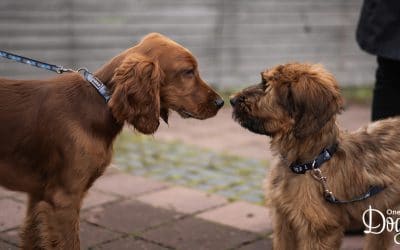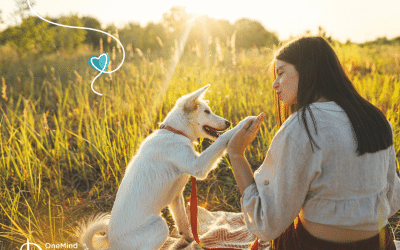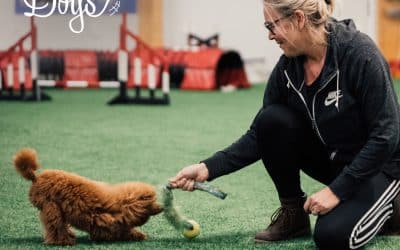Bringing home a new puppy is exciting, but it’s also a big adjustment for both of you. If your puppy would rather go off on its own adventures than listen to you, it may be difficult to help them settle in or start puppy training. Luckily, there are ways to support their needs while building the bond between you.
Understanding your puppy
When you start training your puppy, it can be easy to forget how they’re experiencing the world. To us, they’re precious little bundles we want to nurture and play with. To them, we can be tall, strange, and sometimes scary figures in the beginning – especially when we don’t stop to see the world as they do.
Before you start any session, take a moment to understand their perspective. Dogs are complex and perceptive, so empathy goes a long way to building a connection with them.
Why does my puppy not listen to me?
Don’t worry, it’s normal for puppies to need help adjusting to a new home and routine.
Puppies that are only just starting to socialize with the outside world may struggle to be around other people and pets. Scary experiences in the past may also make them hesitant. Remember: what your puppy finds scary can be completely innocuous to you. Always keep an eye on their body language so you know how they’re feeling.
The space you use for puppy play also plays a big role in how well they appear to listen to you. Even well-socialized puppies struggle to focus when they’re hungry, tired, or surrounded by distractions. If you’re taking them to a new space, fresh smells are a lot more interesting than following instructions!
Don’t worry, though, you can still work with your pup’s natural behavior. How, you might ask? It starts with communication.
What signs should I be aware of?
Your puppy is constantly communicating with you, even when they seem standoffish. Listen when they “talk” so you can respond in the best way.
Flat ears and showing the whites of their eyes are common signs of distress or fear. Be aware of anything that could be stressing your puppy, from loud noises to other dogs nearby. Rolling over can be a playful gesture, but it can also be a way for dogs to show submission if they feel intimidated, especially if they tuck their tails or avoid eye contact.
For the best puppy play sessions, your buddy should be excited but calm enough to focus. An attentive, engaged pup will show you perked ears and a wagging tail, and they’ll have eyes on what you’re doing. A lolling tongue is a good sign that they’re relaxed too. That’s the body language that says I’m ready to play!
How to make sure your puppy will listen to you
Be patient, puppy training rarely starts with a perfect session. Being patient as your puppy adjusts to a new activity goes a long way. It’ll cut stress out of the process for both of you. That’s crucial because dogs learn to pick up cues very early, so the less stressed you are, the less stress they’ll feed off.
Minimize distractions
Another reason to see the world through your puppy’s eyes is to know what distracts them. Try to work in open spaces they’re used to, whether it’s the garden, the park, or the driveway. Anxious pups will appreciate the comfort of familiar surroundings, and hyper ones won’t feel the urge to bound off and explore.
Avoid using places your puppy associates with other activities like the kitchen or near their sleeping area. If you have a dedicated space and make it fun, they’ll learn to associate it with puppy training much quicker.
Establish start and end signals for training
Just like dedicating a space, clear signaling teaches your puppy when it’s time to listen to you.
Start with simple signals like shaking the treat bag and saying “playtime!” You can even ring a bell or make up a whistle to get their attention, but only use it for starting training time.
Use a different signal to end a session so your puppy separates training and normal playtime. Keep it fun by adding a reward like an extra treat or generous shoulder rubs for a job well done.
Keep sessions short
Not only do puppies need a lot of rest, but they also have short attention spans when they’re awake. Limit puppy training to 15 minutes per session at most. You can start with shorter sessions to get them used to the routine and build up as they become more familiar with the exercises.
Take care of their other needs first
Distractions aren’t just passing cars or construction work down the road. Anything that demands your puppy’s focus will make them less likely to listen to you. This includes feeling hungry or tired. The good news is you can build sessions around meal times and sleep schedules!
Timing is everything
Which moments you use for training can play a big role in how well a session goes.
Mealtime is a great opportunity to practice simple exercises like sitting and waiting while you prepare your puppy’s food. If they need a little encouragement, take a small handful of food and use it as a reward as you go. This helps establish a healthy feeding routine, and there’s always a delicious meal at the end!
A wake-up routine is just as helpful, especially since puppies need to relieve themselves after sleeping for long periods. This is the perfect time to take them outside for potty training, and they’ll have plenty of energy for playtime after.
Be as playful as they are
To get your puppy’s full attention, you have to be the most interesting thing they can focus on. Make silly and interesting sounds, stay upbeat, add some variety like moving around between exercises. Do whatever holds their attention and keeps things playful for you, so you’re bonding in the best mind frame.
Keep your sessions light, and remember to have fun yourself! Your puppy is much more likely to listen to you if they know it will be fun.
Would you like a puppy that always listens to you?
OneMind Dogs Online Puppy Training is an online course and app with over 100 fun lessons for the whole family. There’s no need for specialized equipment, and you’ll learn puppy training exercises that are perfect for the home or garden. Sign up for a free 7-day trial today.
Download our Puppy Survival Guide
Fill out the form below for more great tips on common challenges faced by puppy owners. The perfect reminder to print out and stick on the fridge!




